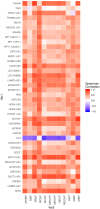Placental lncRNA Expression Is Associated With Prenatal Phthalate Exposure
- PMID: 29385630
- PMCID: PMC5917778
- DOI: 10.1093/toxsci/kfy013
Placental lncRNA Expression Is Associated With Prenatal Phthalate Exposure
Abstract
Phthalates are endocrine-disrupting chemicals that can cross the placenta and affect the fetal epigenome. Among various epigenetic regulators of gene expression, long noncoding RNAs (lncRNAs) are important players that may also be involved in the manifestation of endocrine-disrupting chemical toxicity. We sought to explore the association between maternal urinary phthalate metabolite concentrations and lncRNA expression in human placenta to better understand potential mechanisms through which lncRNAs participate in mediating phthalate toxicity. Ten patients with uncomplicated dichorionic diamniotic twin pregnancies at term were included in this study. Urinary (n = 10) and placenta samples (n = 20) were collected for all participants. Urinary samples were analyzed for 15 phthalate metabolites and 2 phthalate alternative metabolites. Real-time PCR arrays were used to identify and quantify 87 lncRNAs from the placental samples. We tested the Spearman correlation matrix to compare prenatal phthalate measures against placental lncRNA levels. lncRNA levels showed large variations across samples, with no significant differences in lncRNA expression within twin pairs. Mono-(carboxynonyl) phthalate demonstrated consistently strong correlations with most lncRNAs. The strongest correlation was observed between mono-hydroxyisobutyl phthalate and LOC91450 (Rspearman = 0.88, p < .001). This correlation remained significant after Bonferroni adjustment. Other strong correlations were observed between mono-isobutyl phthalate, DPP10 and HOTTIP (Rspearman = -0.91, p < .001). AIRN, DACT3.AS1, DLX6, DPP10, HOTTIP, LOC143666, and LOC91450 were strongly correlated with the greatest number of phthalate metabolites. Further studies are needed to validate these results and understand if the altered expression of lncRNAs in human placenta has clinical significance.
Figures
Similar articles
-
Maternal Phthalate and Personal Care Products Exposure Alters Extracellular Placental miRNA Profile in Twin Pregnancies.Reprod Sci. 2019 Feb;26(2):289-294. doi: 10.1177/1933719118770550. Epub 2018 Apr 24. Reprod Sci. 2019. PMID: 29690855 Free PMC article.
-
A Comprehensive Assessment of Associations between Prenatal Phthalate Exposure and the Placental Transcriptomic Landscape.Environ Health Perspect. 2021 Sep;129(9):97003. doi: 10.1289/EHP8973. Epub 2021 Sep 3. Environ Health Perspect. 2021. PMID: 34478338 Free PMC article.
-
Parental contributions to early embryo development: influences of urinary phthalate and phthalate alternatives among couples undergoing IVF treatment.Hum Reprod. 2017 Jan;32(1):65-75. doi: 10.1093/humrep/dew301. Epub 2016 Dec 7. Hum Reprod. 2017. PMID: 27927842 Free PMC article.
-
Placental outcomes of phthalate exposure.Reprod Toxicol. 2021 Aug;103:1-17. doi: 10.1016/j.reprotox.2021.05.001. Epub 2021 May 17. Reprod Toxicol. 2021. PMID: 34015474 Free PMC article. Review.
-
Using Experimental Models to Assess Effects of Bisphenol A (BPA) and Phthalates on the Placenta: Challenges and Perspectives.Toxicol Sci. 2018 Dec 1;166(2):250-268. doi: 10.1093/toxsci/kfy224. Toxicol Sci. 2018. PMID: 30203063 Free PMC article. Review.
Cited by
-
Mono(2-ethylhexyl) phthalate induces transcriptomic changes in placental cells based on concentration, fetal sex, and trophoblast cell type.Arch Toxicol. 2023 Mar;97(3):831-847. doi: 10.1007/s00204-023-03444-0. Epub 2023 Jan 25. Arch Toxicol. 2023. PMID: 36695872 Free PMC article.
-
The Promises and Challenges of Toxico-Epigenomics: Environmental Chemicals and Their Impacts on the Epigenome.Environ Health Perspect. 2020 Jan;128(1):15001. doi: 10.1289/EHP6104. Epub 2020 Jan 17. Environ Health Perspect. 2020. PMID: 31950866 Free PMC article.
-
Transcriptome Profiling of Placenta through Pregnancy Reveals Dysregulation of Bile Acids Transport and Detoxification Function.Int J Mol Sci. 2019 Aug 22;20(17):4099. doi: 10.3390/ijms20174099. Int J Mol Sci. 2019. PMID: 31443432 Free PMC article.
-
Placenta Disrupted: Endocrine Disrupting Chemicals and Pregnancy.Trends Endocrinol Metab. 2020 Jul;31(7):508-524. doi: 10.1016/j.tem.2020.03.003. Epub 2020 Apr 2. Trends Endocrinol Metab. 2020. PMID: 32249015 Free PMC article. Review.
-
The Placental Epigenome as a Molecular Link Between Prenatal Exposures and Fetal Health Outcomes Through the DOHaD Hypothesis.Curr Environ Health Rep. 2022 Sep;9(3):490-501. doi: 10.1007/s40572-022-00354-8. Epub 2022 Apr 29. Curr Environ Health Rep. 2022. PMID: 35488174 Free PMC article. Review.
References
-
- Bai W., Yang J., Yang G., Niu P., Tian L., Gao A. (2014). Long non-coding RNA NR_045623 and NR_028291 involved in benzene hematotoxicity in occupationally benzene-exposed workers. Exp. Mol. Pathol. 96, 354–360.http://dx.doi.org/10.1016/j.yexmp.2014.02.016 - DOI - PubMed
-
- Bajkin I., Bjelica A., Icin T., Dobric V., Zavisic B. K., Stojanoska M. M. (2014). Effects of phthalic acid esters on fetal health. Med. Pregl. 67, 172–175. - PubMed
-
- Berman T., Hochner-Celnikier D., Calafat A. M., Needham L. L., Amitai Y., Wormser U., Richter E. (2009). Phthalate exposure among pregnant women in Jerusalem, Israel: Results of a pilot study. Environ. Int. 35, 353–357. - PubMed
-
- Bernstein E., Allis C. D. (2005). RNA meets chromatin. Genes Dev. 19, 1635–1655.http://dx.doi.org/10.1101/gad.1324305 - DOI - PubMed
-
- Boeniger M. F., Lowry L. K., Rosenberg J. (1993). Interpretation of urine results used to assess chemical exposure with emphasis on creatinine adjustments: A review. Am. Ind. Hyg. Assoc. J. 54, 615–627.http://dx.doi.org/10.1080/15298669391355134 - DOI - PubMed
Publication types
MeSH terms
Substances
Grants and funding
LinkOut - more resources
Full Text Sources
Other Literature Sources
Medical
Molecular Biology Databases


